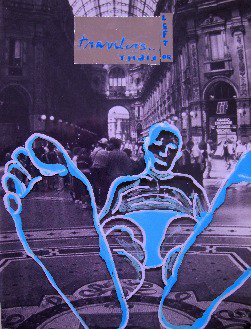We Want to be Free as the Fathers Were
dal 8/9/2010 al 6/11/2010
Segnalato da
Lili Sturm - Centre of Graphic Arts
Viktor Bernik
BridA
Tom Kersevan
Sendi Mango
Jurij Pavlica
Jure Cvitan
Ksenija Cerce
Jon Derganc
Mito Gegic
Bojan Gorenec
Bostjan Jurecic Vega
Ziga Kariz
Gorazd Krnc
Polona Maher
Arjan Pregl
Nina Slejko
Miha Strukelj
Marusa Sustar
Manja Vadla
Saso Vrabic
Tanja Vujinovic
Petja Grafenauer
Bozidar Zrinski
8/9/2010
We Want to be Free as the Fathers Were
International Centre of Graphic Arts MGLC, Ljubljana
The exhibition presents 18 Slovene artists from various generations, all of whom have been dealing with the following questions through their research of the painting medium: How does the contemporary media image of the world show itself in today's painting? How do artists respond to the short-term view, television and internet collages? How do they understand the contemporary media landscape, its characteristics, operation and inclusion into the social microstructure?

Curated by Petja Grafenauer, Božidar Zrinski
Contributing artists: Viktor Bernik, BridA (Tom Kerševan, Sendi Mango, Jurij Pavlica), Jure Cvitan, Ksenija Čerče, Jon Derganc, Mito Gegič, Bojan Gorenec, Boštjan Jurečič Vega, Žiga Kariž, Gorazd Krnc, Polona Maher, Arjan Pregl, Nina Slejko, Miha Štrukelj, Maruša Šuštar, Manja Vadla, Sašo Vrabič, Tanja Vujinović.
The exhibition presents eighteen Slovene artists from various generations, all of whom have been dealing with the following questions through their research of the painting medium: How does the contemporary media image of the world show itself in today’s painting? How do artists respond to the short-term view, television and internet collages? How do they understand the contemporary media landscape, its characteristics, operation and inclusion into the social microstructure?
The 1990s saw a change in visual art as painting reacted strongly to image digitalisation, and the ‘pixellated’ images influenced even the abstract painting which was considered to be the showcase of modernism. In the mid 90s a generation of artists established themselves in Slovenia who understand painting as a screen and who thus adopted the formal image of the electronically and technologically mediated painting.
At the break of the millennia painting became interesting due to its reaction to the flood of media images and the research of the characteristics of the new media in which these images appeared. Today the existence of mediatised images in painting is taken for granted. It is no longer enough for a painting to leave space for the reflection of the broader visual scope within society. The selection of paintings at the exhibition We Want to be Free as the Fathers Were researches the ways in which painting reacts to the broader visual scope at the current moment in time.
The question of paintings that reflect the media image and that was posed already in the 1990s is today of greatest interest to the youngest generation of painters who are just leaving university and are in this exhibition represented by the works of Jon Derganc, Mito Gegič and Maruša Šuštar – joined by the painting of the slightly older Jure Cvitan who can also be placed within this frame. The works of Žiga Kariž, Arjan Pregl and Viktor Bernik focus on the history of art and the great painting themes. The research of the painting’s status in contemporaneity is joined by the opus of the younger generation painter Nina Slejko.
The tendency to experiment and use various painting structures, layers of paint and different ways of placing the image within the painting is typical for Bojan Gorenc and Boštjan Jurečič. The research into the new possibilities for the base upon which the painting can be materialised marks the work of Gorazd Krnc (metal sheets) and Ksenija Čerče (fabrics). Some of Miha Štrukelj’s paintings are made from readymade objects - Lego bricks - which preserve the pixellated surface that has been characteristic for his painting since the late 1990s. Manja Vadla uses recycled waste to create the bases for her paintings.
The wall paintings of Sašo Vrabič are images, compounded from words, on the border between poetry, comic books and paintings. The works of Polona Maher, whose work emerges from sculpting practices, Tanja Vujinović with printed computer animations and the group BridA with its art practice emerging from painting based on the visualisation of digital data all border on the research between painting and other media.
The exhibition is accompanied by the publication of the catalogue which includes texts by Božidar Zrinski and Petja Grafenauer, in both, Slovene and English.
The title of the exhibition is the title of Sigmar Polke's (1941-2010) drawing: Wir wollen frei sein wie die Väter waren, 1964, ballpoint pen on paper, 29,5x21 cm, owner Karlheinz Meyer, Karlsruhe.
Image: Manja Vadla, Boxart, The Lonely Crowd, 2009–10, drawing on foil, cardboard box
Supported by Ministry of Culture of the Republic of Slovenia and The City of Ljubljana.
Opening Thursday, 9 September, at 7 p.m.
International Centre of Graphic Arts
Grad Tivoli, Pod turnom 3, Ljubljana
Hours: Wednesday to Sunday, 11 am - 6 pm.
Free admission





